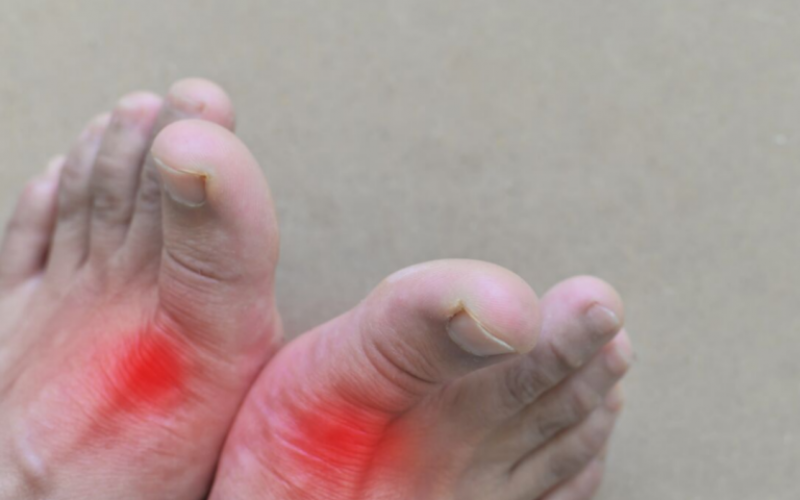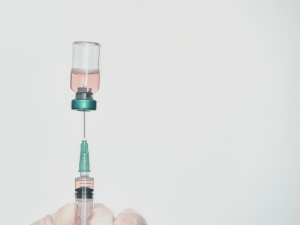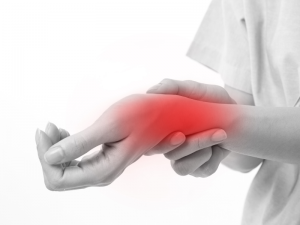Gout is an excruciatingly painful condition caused when uric acid levels build up in the body. It’s a complex form of arthritis and the most common inflammatory arthritis. Approximately 2.5% of adults in the UK will get Gout, with men being more susceptible than women.
The numbers rise as people age with 15% of men and 6% of women over the age of 75 diagnosed with the condition. The big toe is classically the most common joint affected, but it can affect any joint including the ankles, knees, hips, wrists, hands or fingers.
What causes Gout?
Gout is a metabolic illness caused by a chemical process when the urate level builds up in the body. Over time leads to urate crystals forming in and around the joint, which can trigger a sudden painful episode of severe joint inflammation, often called attacks.
Having urate in the blood doesn’t mean people will definitely develop Gout, it’s healthy to have urate in the bloodstream. Approximately 60% of the urate in our body comes from the breakdown of purines present in the cells of our bodies. The rest comes from the breakdown of purines in some foods and drinks. In most people when urate levels build up the body excretes any excess in urine; but, if someone is making too much urate their kidneys may not remove enough, putting them at risk of a Gout attack.
What is a Gout attack?
Gout usually develops very quickly, often late in the day or during the night. Doctors describe this sudden development of symptoms as acute. Typically, the pain is at its most intense in the first 12 to 24 hours of the attack. In most cases, the symptoms settle down within a week to 10 days, but if untreated it can spread to involve new joints.
Symptoms
50% of Gout cases attack the big toe, with symptoms developing rapidly over a few hours, and can include:
- A swollen, stiff joint which can be hot to the touch, and sometimes shiny in appearance
- Noticeable discolouration to the skin around the affected joint; deep red or purple
- Some people also get a fever
- Lumps or bumps may be present in or around the affected joint.
- The pain can be so painful that even light touch or contact with bed sheets can cause intense pain
- Tenderness, irritation or discomfort may be ongoing and last for days or weeks.

Risk factors
For people prone to Gout, several things can trigger a repeat attack including:
- An injury or simple bump or knock to the affected joint.
- Any illness or surgery that raises body temperature.
- Drinking too much alcohol.
- Dehydration.
How is Gout diagnosed?
It important that anyone with a suspected first episode of Gout is examined by a doctor because other conditions that require urgent treatment, such as an infected joint, can sometimes cause similar symptoms.
A diagnosis often based on symptoms and an examination alone but doctors may also suggest the following tests.
- A blood test to measure the level of urate in the blood.
- X-rays but these are rarely helpful in the early years of having Gout.
- Ultrasound can detect earlier signs, am may be helpful when cases are borderline
- Doctors can examine synovial fluid in the joint via a needle biopsy. Although useful to confirm the diagnosis, it isn’t always offered as it can be an uncomfortable test.
Is it Gout or Pseudogout
Some people and health professionals confuse Gout with other conditions which present with similar symptoms. Pseudogout now called Acute Calcium Pyrophosphate Crystal Arthritis, or Severe CPP Crystal Arthritis is another painful condition caused by crystal deposits in the joints. However, it results from calcium crystals rather than urate crystals. There are ways to differentiate the two conditions, in Severe CPP Crystal Arthritis the knee is more commonly affected. Also, while Gout attacks may be preventable with diet and lifestyle changes, pseudogout attacks are not.


Treatment
Gout can be extremely debilitating, but there are several treatments available to help relieve the symptoms and prevent further attacks. Some people can manage their symptoms and have no further attacks. However, lifelong treatment is usually required for many people.
- Non-steroidal anti-inflammatory drugs (NSAIDs)
- Colchicine is not a painkiller, it’s made from the crocus plant, and can be very effective at damping down the inflammation in the joint lining.
- Urate-lowering drugs
- Topical capsaicin cream
- Steroid injections into the painful joint
- Surgery, including joint replacement.
Diet
- People with Gout are often advised to avoid or reduce purine-rich foods including beef, goose, offal, mussels, anchovies, herring, mackerel, yeast, spinach, asparagus, beans, lentils and mushrooms
- Also, oxalate-rich foods such as spinach, rhubarb, black tea, beetroot, chocolate and some nuts.
- Eat cherries or drink unsweetened cherry juice. Studies found that cherries reduce inflammation and drinking unsweetened cherry juice during a Gout occurrence can provide relief.
- Coffee, both regular and decaffeinated coffee has been shown to lower uric acid levels in the body
- Vitamin C, many studies have shown that higher vitamin C intake significantly reduces uric acid levels.
- One of the most effective anti-inflammatory foods is turmeric, studies have shown that curcumin the active ingredient in turmeric helps fight inflammation, interestingly black pepper helps to improve turmeric’s absorption.

Self-help
- Ice packs
- Resting the painful joint
- Losing weight if overweight or obese
- Avoid foods high in purines, excessive alcohol, especially beer and spirits
- Keeping well dehydrated, water will help to flush the toxins out of your body.







